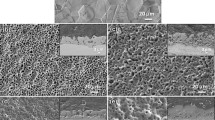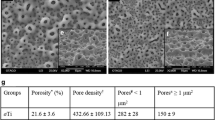Abstract
Surface oxide plays an important role in the biocompatibility of metallic implants. The stability of this surface oxide varies depending on the surrounding environment of the implant. Numerous electrochemical processes may take place during formation and depletion of an oxide layer on the surface through corrosion. This shifts the open circuit potential (OCP) of titanium alloy (generally at ~150 mV vs. SCE) to be more cathodic. Therefore, the relation between cellular response and cathodic potential was investigated in this study first time for the MG63 cells type on the Ti-6Al-4V surface. Initially, the surface was polished and brought to a mirror finish. Then cells were cultured on top of such surfaces kept at two different static cathodic potentials (−300 and −600 mV vs. SCE) for 24 h. The experiments were facilitated using a custom glass corrosion chamber. With shifts toward more cathodic potentials than OCP, it was found that the well-spread viable cells rendered to small, rounded-up, unhealthy cells. This study suggested the apoptotic MG63 cell death due to electrochemical reactions and their products generated under cathodic potentials.








Similar content being viewed by others
References
Pohler OE (2000) Unalloyed titanium for implants in bone surgery. Injury 31:D7–D13
Wintermantel E, Ha S-W (2008) Medizintechnik: life science engineering. Springer, Berlin
Navarro M, Michiardi A, Castano O, Planell J (2008) Biomaterials in orthopaedics. J R Soc Interface 5(27):1137–1158
Sivan S, Kaul S, Gilbert JL (2013) The effect of cathodic electrochemical potential of Ti-6Al-4V on cell viability: voltage threshold and time dependence. J Biomed Mater Res B Appl Biomater 101(8):1489–1497
Keegan GM, Learmonth ID, Case C (2008) A systematic comparison of the actual, potential, and theoretical health effects of cobalt and chromium exposures from industry and surgical implants. Crit Rev Toxicol 38(8):645–674
Spangehl MJ, Younger A, Masri B, Duncan C (1998) Diagnosis of infection following total hip arthroplasty. Instr Course Lect 47:285–295
Gilbert J (2011) Electrochemical behavior of metals in the biological milieu. Compr Biomater 1(1):103
Jacobs JJ, Gilbert JL, Urban RM (1998) Current concepts review-corrosion of metal orthopaedic implants*. J Bone Joint Surg 80(2):268–282
Gittens R, Olivares-Navarrete R, Tannenbaum R, Boyan B, Schwartz Z (2011) Electrical implications of corrosion for osseointegration of titanium implants. J Dent Res 90(12):1389–1397
Gilbert JL, Mehta M, Pinder B (2009) Fretting crevice corrosion of stainless steel stem–CoCr femoral head connections: comparisons of materials, initial moisture, and offset length. J Biomed Mater Res B Appl Biomater 88(1):162–173
Ehrensberger MT, Sivan S, Gilbert JL (2010) Titanium is not “the most biocompatible metal” under cathodic potential: the relationship between voltage and MC3T3 preosteoblast behavior on electrically polarized cpTi surfaces. J Biomed Mater Res A 93(4):1500–1509
Contu F, Elsener B, Böhni H (2004) A study of the potentials achieved during mechanical abrasion and the repassivation rate of titanium and Ti6Al4V in inorganic buffer solutions and bovine serum. Electrochim Acta 50(1):33–41
Gilbert JL, Zarka L, Chang E, Thomas CH (1998) The reduction half cell in biomaterials corrosion: oxygen diffusion profiles near and cell response to polarized titanium surfaces. J Biomed Mater Res 42(2):321–330
Venugopalan R, Weimer JJ, George MA, Lucas LC (2000) The effect of nitrogen diffusion hardening on the surface chemistry and scratch resistance of Ti-6Al-4V alloy. Biomaterials 21(16):1669–1677
Haeri M, Wöllert T, Langford GM, Gilbert JL (2012) Electrochemical control of cell death by reduction-induced intrinsic apoptosis and oxidation-induced necrosis on CoCrMo alloy in vitro. Biomaterials 33(27):6295–6304
Haeri M, Wöllert T, Langford GM, Gilbert JL (2013) Voltage-controlled cellular viability of preosteoblasts on polarized cpTi with varying surface oxide thickness. Bioelectrochemistry 94:53–60
Haeri M, Gilbert JL (2013) Study of cellular dynamics on polarized CoCrMo alloy using time-lapse live-cell imaging. Acta Biomater 9(11):9220–9228
Ciolko AA, Tobias M, Ehrensberger MT (2015) The effect of fretting associated periodic cathodic potential shifts on the electrochemistry and in vitro biocompatibility of commercially pure titanium. J Biomed Mater Res B Appl Biomater 104(8):1591–1601
Kalbacova M, Roessler S, Hempel U, Tsaryk R, Peters K, Scharnweber D, Kirkpatrick JC, Dieter P (2007) The effect of electrochemically simulated titanium cathodic corrosion products on ROS production and metabolic activity of osteoblasts and monocytes/macrophages. Biomaterials 28(22):3263–3272
Ehrensberger MT, Gilbert JL (2010) The effect of static applied potential on the 24-hour impedance behavior of commercially pure titanium in simulated biological conditions. J Biomed Mater Res B Appl Biomater 93(1):106–112
Clechet P, Martelet C, Martin J, Olier R (1979) Photoelectrochemical behaviour of TiO 2 and formation of hydrogen peroxide. Electrochim Acta 24(4):457–461
Chiarugi P, Pani G, Giannoni E, Taddei L, Colavitti R, Raugei G, Symons M, Borrello S, Galeotti T, Ramponi G (2003) Reactive oxygen species as essential mediators of cell adhesion the oxidative inhibition of a FAK tyrosine phosphatase is required for cell adhesion. J cell biol 161(5):933–944
Acknowledgements
We are very thankful to Richard Frueh, Physical Sciences Machine Shop, UIC Department of Physics, Brian D. Schwandt, Glass shop, UIC Department of Chemistry, for their aid and assistance in designing the corrosion chamber for this work, and the National Science Foundation (CBET #1067424 and DMR #1307052) for the financial support.
Author information
Authors and Affiliations
Corresponding author
Ethics declarations
Conflict of interest
On behalf of all authors, the corresponding author states that there is no conflict of interest.
Rights and permissions
About this article
Cite this article
Bishal, A.K., Grotberg, J., Sukotjo, C. et al. Human Osteoblast Cell-Ti6Al4V Metal Alloy Interactions Under Varying Cathodic Potentials: A Pilot Study. J Bio Tribo Corros 3, 40 (2017). https://doi.org/10.1007/s40735-017-0101-4
Received:
Revised:
Accepted:
Published:
DOI: https://doi.org/10.1007/s40735-017-0101-4




